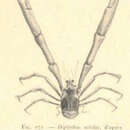en
names in breadcrumbs


“Genus Uroptychus, n. n.
Diptychus,1 A. Milne-Edwards, Bull. Mus. Comp. Zool, vol. viii. No. 1, p. 61, 1880.
Rostrum flattened and acute, resembling that of Galathea. Carapace somewhat ovate in shape, with its surface glabrous and usually devoid of spines. Chelipedes elongated and of varying width; the ambulatory limbs slender. Eye-stalks short and stout, the corneæ scarcely dilated. Antennal peduncle slender, the first free joint provided with a flattened and acute acicle or movable spine; the flagellum never of great length, and in some cases remarkably short. External maxillipedes comparatively smooth, with the terminal joints elongated, more especially the propodus, which is considerably longer than any of the other joints. Abdomen smooth and glabrous externally, folded on itself; the telson (which is transversely segmented and of very small size), as well as the last pair of appendages, bent under the preceding segments and applied to the thoracic sterna; males with the first two pairs of appendages (copulatory organs) fairly well developed, those of the third and fourth segments rudimentary, of the fifth absent; females with two pairs of ovigerous appendages on the third and fourth segments, those of the other segments (with the exception of the penultimate) absent. Eggs comparatively few in number, and of large size.
The species are mostly of small size, and characterised by the shining polished surface of their body and limbs. They are widely distributed, occurring at depths of about 100 to 700 fathoms, and many of the species appear to live among the branches of Corals, their limbs being specially adapted for clinging. The atrophy of the caudal swimming fin is carried to a greater extent than in either Ptychogaster or Eumunida, and it is probable that the folding in of that part is a result of this condition in all three genera. In one respect Uroptychus differs from all other Galatheids, viz., in the presence of a distinct movable acicle on the first free (in reality the second) joint of the antennal peduncle, an important and primitive character, but it must be remembered that a similar process, though of very small size, is present also in Eumunida. In those species which I have examined, the fifth arthrobranchia, counting from before backwards, is not of larger size than the others, whereas in most of the Galathodea it is distinctly enlarged. Professor A. Milne-Edwards has made known five species from the West Indies, dredged during the "Blake " expedition, and more recently another species from the "Talisman " dredgings in the North Atlantic.
1 As this name has been previously used in Zoology to designate a genus of Cyprinoid Fishes, I have altered it to that given above.”
(Henderson, 1888)